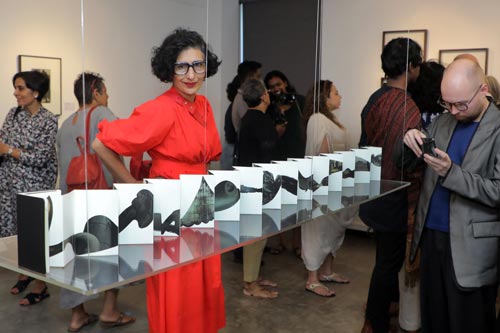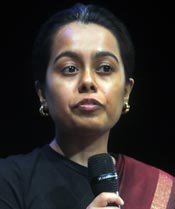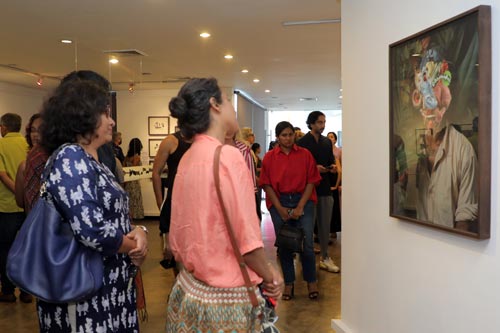Image making re-imagined, interpreted and challenged

Taking in Pivot Glide Echo: Many aritsts, many shades of expression. Pix by M.A. Pushpa Kumara
Stepping into Pivot Glide Echo – the inaugural exhibition of KALA – the new platform for showcasing South Asian modern and contemporary art both from the local and diasporic perspectives you are transported into a world of image-making. Image making re-imagined, interpreted, and challenged. KALA is now on at the Lionel Wendt Art Centre and will continue until February 25.
With the works of Sri Lanka’s most celebrated photographer Lionel Wendt serving as a catalyst, the works of artists spanning eight decades are presented together to offer new possibilities of image-making.
“The exhibition is broken into six clusters that have a unique story for themselves but also work harmoniously with each other,” explains Mariyam Begum, KALA’s Assistant Curator taking the Sunday Times on an exclusive walk-through of the exhibition. Mariyam worked with KALA’s Curatorial Advisor Sandhini Poddar, Adjunct Curator at Large of the Guggenheim, Abu Dhabi, on the exhibition.
“These pieces push us to rethink image-making, from the somewhat conventional art of where you would see a form of an object or a landscape to re-directing and re-interpreting it innovatively to challenge the possibilities of visual image making,” she says.

KALA’s Assistant Curator: Mariyam Begum
In the ‘Poems inspired by landscapes’ cluster, Muhanned Cader’s works that carry interpretations of Wendt’s photographs show a deep contemplation on history and politics, while Vasantha Yogananthan’s works seek to capture the fleeting yet decisive moment of the landscape. “If that moment was missed the visual would have completely changed into something different to what we would be looking at now,” Mariyam notes.
In contrast, in Rupaneethan Pakkiyarajah’s drawings we see trauma experienced in the north translated into a bodily experience through an old tradition of poetry in Tamil named ‘Akam’- a poetic expression of love, longing, and desire.
While Wendt and Yogananthan have captured fleeting moments and translated them into images showcasing their brilliant observational skills, the cluster ‘Temporality’ sees artists Anoli Perera depicting colonial patriarchy through photography, and Liz Fernando who went through the processes of archiving, preserving and reproducing, engaging with temporality differently by interpreting the images of the past and re-writing them. Contrastingly artist Muvindu Binoy’s installation was digital images and generative AI created by rapidly expanding fields of information. Raki Nikahetiya’s take on the cluster was about revealing the unseen beauty of materials collected from the past by enlarging scanned microscopic images.
 Mariyam emphasized how each artist’s take on the cluster is different but also perfectly in tune making it easy to flow from one artist’s work to another.
Mariyam emphasized how each artist’s take on the cluster is different but also perfectly in tune making it easy to flow from one artist’s work to another.
“Repetition that creates fluidity, rhythm, and harmony are key elements that run throughout the exhibition, in a way by which they all connect with Wendt’s work,” she says, adding, “you are encouraged to admire the repetitive formation in everyday life,” as we climb down the stairs to the cluster ‘Rhythm’. Rhythm appears as a preoccupation on Wendt’s work from architecture to the human body— which is what George Claessen created through the control of the brush for interactions of translucency and opacity and Sebastian Posingis appreciated in Bawa’s work by re-creating some archived architectural photos that reflected on Wendt’s work of light and geometry.
Kavan Balasuriya exploited Wendt’s negotiations with the interplay of light, shadow and reflection through etchings done on an aluminum foil – the creations determined by incidental light and the viewer’s position in space.
In the outdoor area of the theatre, Mariyam leads us to the cluster ‘Evocative Potentials’ where we see the sculpture by Kingsley Gunatillake inspired by medieval Japanese and Chinese ink paintings tying into the conversation of fluidity and rhythm through the malleable properties of metal.
Walking into the next space she guides us through 3D installations by Mahen Perera who uses a range of discarded materials such as upholstery, wood, fabric, cement and plaster to create suggestive sensual forms. Also using different types of materials such as metal spoons, ice-cream sticks, wire, and tissue in his work is H. A. Karunaratne.
These artists’ creations—seen together with Wendt’s create a trail in Sri Lankan contemporary art. “They are all about bringing fantasy and anything that cannot be captured on camera into life through these physical pieces.”
Cassie Machado, Saskia Pintelon, and George Keyt’s work feature in the cluster ‘The Body’ – as a site of expression and experience. In collaboration with Wendt’s work, Cassie used a technique called photogram innovatively to depict cross-culture identity through human figures. Pintelon engages viewers in an unsettling engagement with the gaze as we begin to re-examine our socio-cultural contexts being the subjects. Wendt’s intimate engagement with the human form—notably the male body was re-interpreted by the work of Keyt’s references to the centuries-old traditions of figurative painting and sculpture in medieval India. The masculinity portrayed in his photographs was embraced and converted into certain tenderness by these artists paving the way for provocative and intriguing conversations on the gaze and sexuality.
The ‘Redefining Image-Making’ cluster is about celebrating and capturing how these artists in their time have become pioneers by challenging the possibilities of visual image-making. Creating abstract collages using everyday objects, Ivan Peries played with arrangements and perspectives in his work just like Wendt experimented with ideas of illusion, perspective, and scale. L. T. P. Manjusri pushed the limits of form through an unconventional, suggestive and sensual take on the human body showing aesthetic qualities of surrealism in his work which in turn relates to Mahen’s work.
A celebration of intergenerational dialogues between modern and contemporary artists from Sri Lanka and the diaspora as well as celebrating Wendt’s career and art, Pivot Glide Echo is a must-visit for all art lovers.
| Access to exhibition | |
| Access to the exhibition will be free of charge on Monday, February 5 and Wednesday, February 24 from 10 a.m. – 6 p.m. On other days, a pass is priced at Rs 300. Season pass Rs 1000. Free access for VIP pass holders, students, and senior citizens. For more on KALA, and dates of curated walk throughs, see kalasouthasia.com
|
Searching for an ideal partner? Find your soul mate on Hitad.lk, Sri Lanka's favourite marriage proposals page. With Hitad.lk matrimonial advertisements you have access to thousands of ads from potential suitors who are looking for someone just like you.


